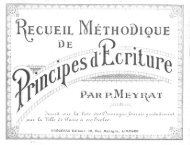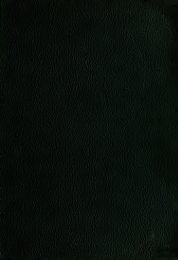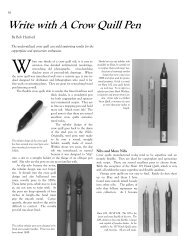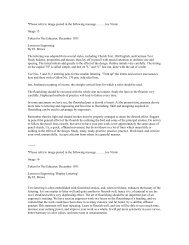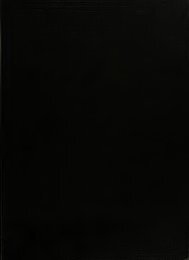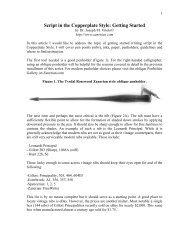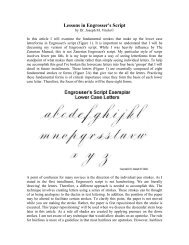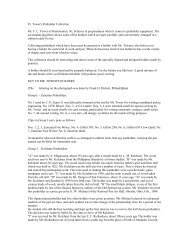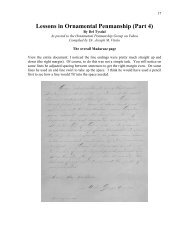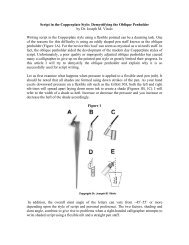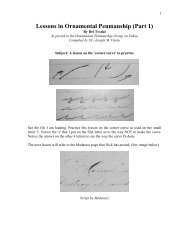The Educator (Volume 45) - IAMPETH
The Educator (Volume 45) - IAMPETH
The Educator (Volume 45) - IAMPETH
You also want an ePaper? Increase the reach of your titles
YUMPU automatically turns print PDFs into web optimized ePapers that Google loves.
12<br />
Perceptual Learning of Letter Formation<br />
In diagnosing the defects in specimens<br />
of handwriting letter formation<br />
is often found to be a cause of deficiency.<br />
Likewise, letter formation<br />
seems to involve other handwriting<br />
-characteristics such as slant, alignment,<br />
and spacing. Many times in<br />
scoring letter formation receives double<br />
the rating as do other qualities.<br />
Instruction in penmanship and remedial<br />
handwriting must both include<br />
a treatment of letter formation.<br />
Psychologists, as well as penmanship<br />
specialists, recommend that visualization<br />
be employed as a basis for<br />
teaching letter formation. Wheat<br />
from the psychological point of viewpresents<br />
the following explanation.<br />
Learning to write is the gradual<br />
adaptation of the handwriting<br />
movement to a gradually developing<br />
perception of form. One<br />
finds, moreover, that out of the<br />
development of perception comes<br />
quality of product, and that the<br />
relation between speed and quality<br />
of handwriting may be distinguished<br />
in the relation which<br />
exists between the adaptation of<br />
the movement and the development<br />
of perception. . . .1<br />
Dr. Frank N. Freeman contends<br />
that one of the causes for poor letter<br />
formation is that the pupil fails to get<br />
By Dorothy Leggitt, Wydown School,<br />
Clayton, Missouri<br />
a clear idea of the letter.- <strong>The</strong> role<br />
visualization plays is well expressed<br />
by Fred C. Ayer: "Most handwriting<br />
systems make considerable use of the<br />
device of visualization, by virtue of<br />
which pupils attempt to reproduce<br />
writing from memory. "3<br />
This theory of visualization of letter<br />
formation results in unique teaching<br />
of handwriting.<br />
Writing is no longer presented<br />
through the teaching of many<br />
principles formerly used, but<br />
through a letter, a group of letters,<br />
or a word as a unity, with<br />
occasional reference to the<br />
straight line, the left and right<br />
curves as elements.<br />
All letters of the alphabet are<br />
developed from the oval and<br />
straight line drills or from a<br />
modified form of either one or a<br />
combination of the two. By<br />
dividing an oval with the oblique<br />
straight line, we have the right<br />
curve and the left curve. <strong>The</strong>se<br />
elements may be taught to good<br />
.••<br />
advantage. . .<br />
Similar descriptions of parts of letters<br />
appear in other penmanship lesson<br />
units' and become a part of supervisory<br />
recommendations and of remedial<br />
procedures.*<br />
Listed among hindrances to hand-<br />
r<br />
/ / / .^<br />
^ /,/ t ' *<br />
writing instruction are (1) lack of<br />
natural interest by pupils and (2)<br />
lack of devices and artificial incentives<br />
to progress.' In acceptance of<br />
such a challenge a perceptual learning<br />
penmanship test has been devised<br />
and found successful.* This test and<br />
its administration also meet the requirement<br />
for stressing learning of<br />
letter formation through perception<br />
of form.<br />
'Harry Giove Wheat. <strong>The</strong> Psychology of<br />
Elementary School Subjects. New York: Silver.<br />
Burdett and Company, 1931. P. 261.<br />
-Frank N. Freeman. Correlated Handwriting.<br />
Junior High School Manual. Columbus.<br />
Ohio: Zaner-Bloser Co.. 1932.<br />
'Fred C. Ayer. "<strong>The</strong> Attainment of Objectives<br />
in HandwritinK." Elementary School<br />
Journal. XXVIII (Sept.. 19271. 50-1.<br />
'A. N. Palmer Company, Palmer Method<br />
Handwriting, Teacher's Manual. New York<br />
<strong>The</strong> A. N. Palmer Co.. 1932. P. 63.<br />
Ellen C. Nystrom, Self-Corrective Handwriting<br />
Charts. Minneapolis, Minne?^ota:<br />
Ellen C. Ny.strom for the Board of Education,<br />
1927. Lesson X.<br />
^'Lucretia Cavanah and Alonzo F. Myers.<br />
Diagnostic, Individual, Remedial Unit. New<br />
York : American Book Company, 1937. Pp.<br />
34-43.<br />
Paul V. West. Changing Practice in Handwriting<br />
Instruction. Bloomington. Illinois:<br />
Public School Publishing Company. 1927.<br />
"Experiment carried on in ninth grade at<br />
Wydown School. Clayton, Missouri, by Dorothy<br />
Leggitt.<br />
%,, y^ / ,/- J.. J^y<br />
n' ,.<br />
-^y Jy<br />
'"y/.-<br />
J^.i-^yyy- ''y/.yAyJ:. ,y'<br />
,/; / ^ I<br />
, y /<br />
j:^ "Jy yy '^y yjyAyoyyiy y^y^/^y ''qy<br />
/i/'^y y^jy y<br />
^^<br />
a<br />
^<br />
1 f /ff^ /d //<br />
T .J /<br />
/ / / /<br />
r^ 'V-/<br />
/<br />
._^<br />
//<br />
^ o ^<br />
'^ y jy ''yty<br />
-<br />
, y<br />
"Jy "J.^y rr-<br />
'"^. ^y Jo, y6y<br />
^ 7 /<br />
/<br />
/<br />
/'<br />
19<br />
.yry<br />
30<br />
y'<br />
.<br />
J<br />
y<br />
:



